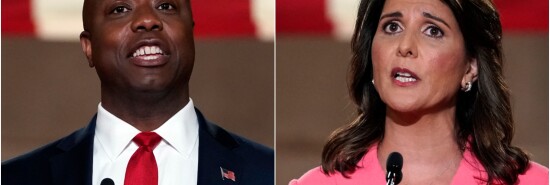
The GOP race and the ‘donor class’
Byron York
THE GOP RACE AND THE “DONOR CLASS.” There’s a lot of media talk these days about the Republican “donor class” and its preferences in the 2024 GOP presidential race. That’s natural at this stage of the contest, in part because 1) people with billions of dollars hold an outsize place in journalists’ minds, 2) the political class, composed of candidates, consultants, officeholders, media, and other insiders see money as an important measure of a candidate’s viability, 3) candidates kiss up to billionaires and lavish attention on them, and 4) most importantly, the voters haven’t spoken yet.
What is abundantly clear right now, in the 2024 GOP race, is that the donor class and the voters are not aligned. The short version is: The Republican donor class wants to get rid of former President Donald Trump, and the party’s voters want to elect him.
Just look at this week’s debut of Sen. Tim Scott’s (R-SC) presidential campaign. Though well liked in the Senate and by voters in his home state of South Carolina, Scott is not exactly a national figure at the moment. A month ago, he was below 1% in the RealClearPolitics average of national polls. Now, he has shot all the way up to 1.9%. Nevertheless, Scott is rolling in cash.
Subscribe today to the Washington Examiner magazine that will keep you up to date with what’s going on in Washington. SUBSCRIBE NOW: Just $1.00 an issue!
“Mr. Scott will have more than enough money to find out if there’s a bigger market for his ideas than the polls suggest,” the New York Times reported. “His support for pro-business policies has made him a favorite of the Republican donor class and he has billionaires like the Oracle founder Larry Ellison — who was aligned with Mr. Trump while he was in the White House — who are willing to put millions of dollars behind his campaign.” So far, Ellison has contributed about $25 million to Scott’s super PAC.
At his campaign rollout in Charleston, South Carolina, Scott said, “I’ve got great mentors. … One of my mentors, Larry Ellison, is with us today.” Twenty-five million dollars is a lot of mentoring, and Ellison is reportedly prepared to mentor Scott even more in the future.
The other new arrival in the race this week, Gov. Ron DeSantis (R-FL), also has a donor, hotel tycoon Robert Bigelow, who has so far put more than $20 million into DeSantis’s super PAC. The group, Never Back Down, expects to raise and spend around $200 million to help DeSantis.
The donors supporting Scott and DeSantis are part of a larger class of wealthy Republicans trying to stop Trump. “Key Republicans are trying to choke off any momentum that Donald Trump can build for a third White House campaign to make room for a fresh GOP standard bearer,” Bloomberg Politics reported recently.
Of course, no one has voted yet. In public opinion polls, Trump has a huge lead over everybody in the growing Republican field. In the latest RealClearPolitics average of national polls, Trump has a 32.6-point lead over DeSantis, a 49.2-point lead over former Vice President Mike Pence, a 49.3-point lead over former U.S. Ambassador to the United Nations Nikki Haley, a 51-point lead over Vivek Ramaswamy, and a 52-point lead over Scott.
Polls always come with a warning: They reflect the state of the race at this moment and are not a prediction of where the race will be at some point in the future. In this case, the polls raise an obvious question, and that is whether Trump’s majority will leave him for anyone else. Under what circumstances, if any, might that happen? There are no answers to that question.
What is happening now is a small group of people, the donor class, is hoping that the application of hundreds of millions of dollars will nudge those voters away from their current support of Trump. And if that doesn’t work, some hope that the application of hundreds of millions of dollars plus another indictment or two might do the trick.
But millions in negative advertising, and even another indictment or two, might not move those voters away from the former president. Many believe in Trump and want him to be president again. There aren’t enough of them to make him president again, but there are enough of them to make him the Republican nominee again. Maybe they will change their minds during the Republican primary season, and maybe they won’t.
And here’s the thing: Whatever they decide is OK. In the end, the process is critically important. Voters select the party’s nominee. If the nominee they pick leads the party to disaster in the general election, then so be it.
Parties sometimes wander into the wilderness. The Democratic Party lost presidential elections in 1968, 1972, 1980, 1984, and 1988 before they admitted they were out of touch with the nation on some key areas. It was a long wilderness, and some Democrats began to worry that they would never win the White House again, but the party eventually righted itself and regained its competitiveness with a victory in 1992.
There is no evidence that the Republican Party is about to enter a decadeslong stay in the wilderness. But if GOP voters reject perfectly fine primary candidates like DeSantis, Pence, Haley, Scott, and others in favor of Trump and then Trump loses — well, that is what can happen. Parties sometimes go off in the wrong direction and are rewarded with defeat.
No doubt some big Republican donors believe they are trying to save the party from Trump. But they don’t decide things.
For a deeper dive into many of the topics covered in the Daily Memo, please listen to my podcast, The Byron York Show — available on the Ricochet Audio Network and everywhere else podcasts can be found. You can use this link to subscribe.
